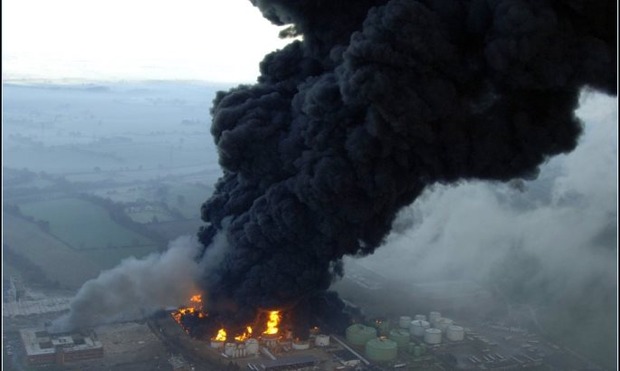Process safety: barely begun
11 Mar 2015
Ten years on from the Buncefield explosion, only small steps have been taken to establish a process safety culture in the workplace.
What does an industry that places safety as its number one priority look like? Presumably it doesn’t look like one where hundreds of safety incidences still occur at major hazards sites every year and a major industry-wide training initiative fails to secure even half of the level of support it had hoped for.
However, this is the state of the UK process industry in 2015, the year that marks 10 years since the Buncefield oil terminal explosion in Hemel Hempstead, Hertfordshire.
There are still some businesses that don’t realise that process safety is part of what they do
HSE chairman Judith Hackitt
At the end of this month a new strategy to deal with Process Safety Management will be launched by Cogent Skills, the new skills body for the process industries formed by last month’s merger of the National Skills Academy for the Process Industries and the Cogent sector skills council.
A key element in finalising the strategy was an industry conference held in London in January, organised by the Process Safety Management Project Board. Formed in 2010, this body comprises senior representatives from Cogent Skills, the Chemical Industries Association (CIA), the Health and Safety Executive (HSE), the Institution of Chemical Engineers (IChemE), the Institution of Mechanical Engineers (IMechE), the UK Petroleum Industries Association (UKPIA), the Tank Storage Association (TSA) and Unite the Union.
While speakers did their best to convey how much progress has been made in the 10 years since Buncefield, it soon became apparent that overall industry interest and commitment to process safety remained at frighteningly low levels.
“Many companies large and small have yet to engage [in process safety],” said Pentagon Chemicals chief executive and Process Safety Management Project Board chairman Allan Laing.
“Those of us that have tried to implement process safety management, we know that the harder we push, the more difficult it gets.”
Further evidence of low levels of engagement was provided by Cogent Skills head of workforce development Neil Smith.
In reviewing the previous Process Safety Management strategy, Smith revealed that the skills bodies had managed to engage less than half of the companies with sites registered under the Control of Major Accident Hazards (COMAH) Regulations (see box below) than they had originally hoped to.
“We set out targets for 2012-14 with the ambition to engage 250 of the top COMAH sites,” said Smith.
“We only engaged 90 companies. For lower tier COMAH sites we aimed for 180 sites, and have only actually been able to engage 43 companies. This is nowehere near where we wanted to be.”
While some of this apparent apathy could be explained by companies choosing to use courses other than those provided by Cogent Skills, the size of the shortfall in take-up did nonetheless prompt other speakers to voice their concerns that complacency still existed in many companies’ approach to process safety.
“One of the big challenges we had after Buncefield was that people said ‘on my site we could never have that kind of incident’,” said Ken Rivers, chairman of the COMAH Strategic Forum, a body that brings together COMAH enforcement bodies such as the HSE and the Environment Agency (EA) and industry representatives from TSA, UKPIA, CIA & the Chemical Business Association (CBA).
“They would say ‘we have highly trained operators, computer systems telling me if a tank is overfilling. We have High Level alarms. It could never happen to me’.”
The explosion at the Buncefield Depot in Hertfordshire occurred at around 6am on Sunday 11 December 2005.
The Buncefield site was a large fuel tank farm used by a number of oil companies including Total, Chevron, BP and Shell.
The cause of the explosion was the ignition of a vapour cloud that had developed from the spillage of some 300 tonnes of petrol from a storage tank.
This spillage occurred due to the tank being overfilled with petrol after a gauge measuring the level of petrol in the storage tank became stuck.
The tank did have High Level alarms to warn operators in the control room that it was near full, but because the level measurement gauge had become stuck, these alarms were never triggered.
According to Solvay Interox HR manager Jean Allen, the post- Buncefield attitude of “it won’t happen to me” described by Rivers is still prevalent today. Solvay Interox Warrington is a top tier COMAH site that stores hydrogen peroxide.
“We have a blue line signifying difference between plant side where personal protection equipment (PPE) is used and the office where it is not,” says Allen. “The attitude of many working on the plant side to management getting involved in process safety is ‘Don’t worry about the plant side, we take care of that’.”
HSE chairman Judith Hackitt, a process engineer, told the conference that the level of apathy towards process safety was particularly alarming at sites run by smaller companies.
“There are still some businesses that don’t realise that process safety is part of what they do,” said Hackitt.
She blamed this partly on the fragmentation of the process industries.
“There are now a much greater number of smaller entrepreneurial companies operating major hazard facilities, often without the back-up of extensive in-house technical resources,” said Hackitt.
“How much expertise do they have in process safety? We cannot fall into the trap of small equals low or lower risk or, worse still, relaxation of standards because it’s a smaller enterprise.”
Hackitt then cited the example of Euticals, a pharmaceutical manufacturer in North Wales.
During an inspection in November 2012, 130 tonnes of a production waste bi-product was found, IsoSorbide DiNitrate (ISDN).
When dry, ISDN has explosive characteristics similar to TNT.
The operator did not have hazardous substance consent for the storage and had no risk assessment for it.
“I find it amazing that there are people in warehouses storing dangerous substances that say process safety doesn’t apply to them,” she said.
“If I had stood here three years ago and described this [Euticals] scenario to you as even a possibility, I am sure you would have told me categorically that it could not happen, but it did. This was a CIA member company, a Responsible Care company. It raises serious questions arise about leadership and management of process safety, and of knowledge and competence.”
Even if, as the Euticals case illustrates, the worse offenders are to be found at smaller or lower risk sites, the speed of process safety take-up among major firms has still been less than rapid.
To read the rest of this article and receive regular updates on safety issues, please register here.
COMAH Again
The current Control of Major Accident Hazards (COMAH) Regulations 1999 will be repealed on 31 May 2015 to be replaced on 1 June 2015 with the COMAH Regulations 2015.
COMAH aims to prevent and mitigate the effects of those major accidents involving dangerous substances such as chlorine, liquefied petroleum gas, explosives and arsenic pentoxide that can cause serious damage and harm to people and the environment.
Operators of sites that hold larger quantities of dangerous substances (‘top tier’ sites) are subject to more onerous requirements than those of ‘lower tier’ sites.
The new COMAH regulations being introduced this summer implement the EU’s Seveso III Directive. One of the key drivers for Seveso III was the European Regulation on classification, labelling and packaging of substances and mixtures (CLP) coming fully into force on 1 June.
According to HSE chairman Judith Hackitt, “the change to CLP may result in some sites not currently covered by COMAH coming into scope, and some existing establishments may drop out”.
“There may also be some movement between the tiers,” she adds.
As of 1 June COMAH site operators will also have to provide information to the public about their sites in a permanently available electronic form.







